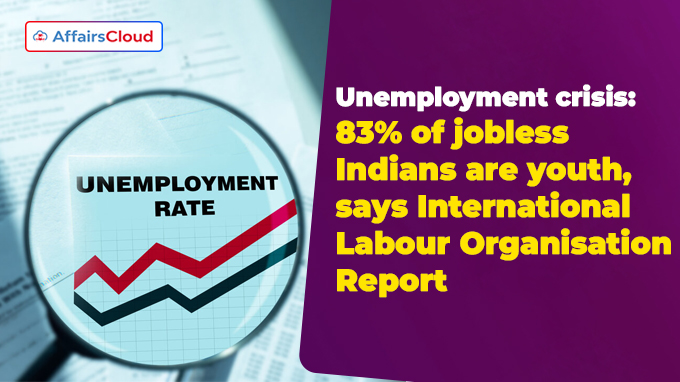 According to the ‘India Employment Report 2024: Youth education, employment and skills’ jointly published by the International Labour Organization (ILO) and the Institute of Human Development (IHD), India’s youth accounts for almost 83% of the unemployed workforce in India.
According to the ‘India Employment Report 2024: Youth education, employment and skills’ jointly published by the International Labour Organization (ILO) and the Institute of Human Development (IHD), India’s youth accounts for almost 83% of the unemployed workforce in India.
- The report was released by V.Anantha Nageswaran, Chief Economic Advisor (CEA) of India.
- He mentioned that the report showed the youth employment and underemployment increased between 2000 and 2019 but declined during the COVID-19.
Key Findings of Report:
i.The report highlighted that significant percentage of educated youngsters with secondary or higher education in the total unemployed has almost doubled from 35.2%(2000) to 65.7%(2022).
ii.As per the report, the Labour Force Participation Rate (LFPR), Worker Population Ratio(WPR) and the Unemployment Rate (UR) declined consistently between 2000 and 2018.
- But, these indicators witnessed an improvement after 2019. The improvement coincides with period of economic distress during both pre and post COVID-19.
iii.The report mentioned that India’s job story over the last 20 years witnessed some paradoxical improvements in labour market indicators.
- The report noted that after 2019, there was an increase in agricultural employment and decrease in non-farm employment particularly in the manufacturing sector.
- The construction and services sectors absorbed the increase in non-farm employment.
iv.The report highlighted certain factors in education sectors which cause unemployment among educated youth:
- High dropout rates after secondary education especially among poor sections of society.
- Lack of quality education in secondary and higher education.
v.Employment:
- The report highlighted that the increase in employment after 2019 was mainly due to self-employed workers.
- The report also noted that nearly 82% of the workforce engages in the informal sector, and informal employment comprises about 90% workers.
- Regular employment saw an increase after 2000, but, after 2018 witnessed decline.
vi.The report noted lack of skills among youth such as:
- 75% of youth unable to send emails with attachments.
- 90% of Indian youth are unable to put mathematical formula into a spreadsheet.
- 60% of youth are unable to copy and paste files.
vii.The report projected urbanisation and migration rates will substantially increase. It estimated a migration rate of around 40% by 2030 which will increase urban population.
viii.The report underscored the widening gender gap in the labour market. Women with higher education face challenges in securing employment.
ix.The report cited widespread livelihood insecurities and existing social protection schemes are not sufficient.
x.The report sheds light on growing social inequalities despite targeted policies. Scheduled Caste(SC) and Scheduled Tribe(ST) communities face social discrimination to get better job opportunities.
xi.Wages:
- Wages largely remained the same or declined, with real wages for regular workers.
- Wages for self-employed individuals showed a negative trend after 2019.
- Large percentage of unskilled casual workers failed to receive mandated minimum wages in 2022.
xii. Of the 3 main categories, the dominant category of employment in India remains self-employment (55.8%), followed by casual employment (22.7%) and regular employment (21.5%).
Challenges:
i.Technological advancements affected the demand for skills and types of employment.
ii.Regional disparities exist in youth employment outcomes across Indian states.
iii.The report projected that the youth population which accounts for 27% of total population in 2021 will decrease to 23% by 2036.
iv.Challenges induced by COVID-19 pandemic in the youth labour market.
Key Recommendations:
The report suggested 5 key policy areas to improve:
i.promoting job creation
ii.improving the quality of employment
iii.addressing inequalities in the labour market
iv.strengthening both skills and policies of active labour market
v.bridging the learning deficits on labour market patterns and youth employment.
About International Labour Organisation(ILO):
Director-General -Gilbert Fossoun Houngbo
Headquarters – Geneva, Switzerland
Established – 1919
Member States – 187 Member States




